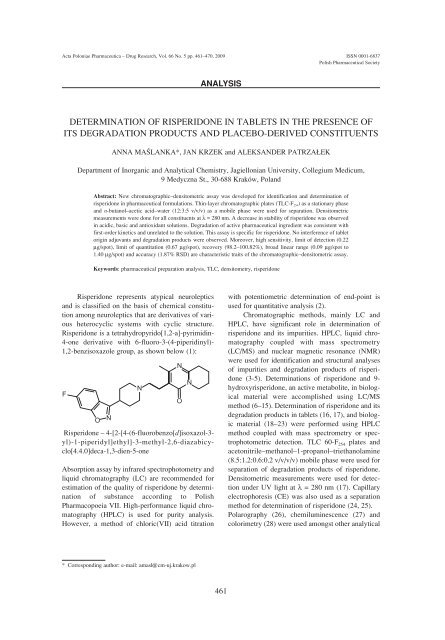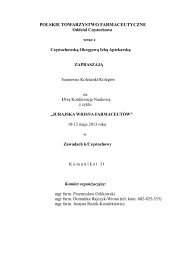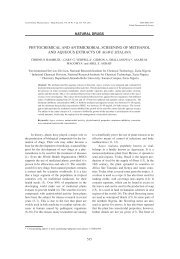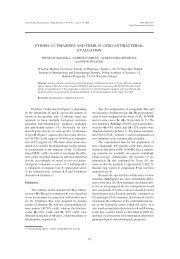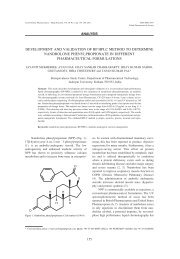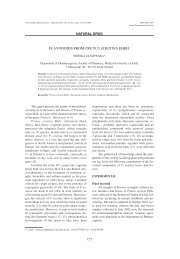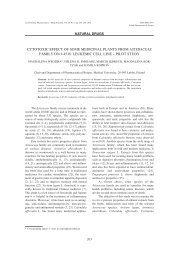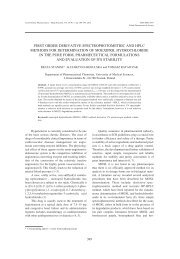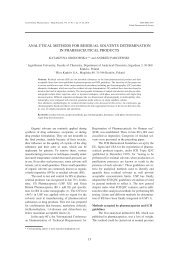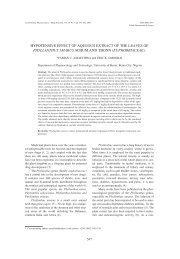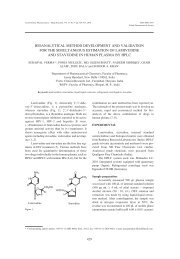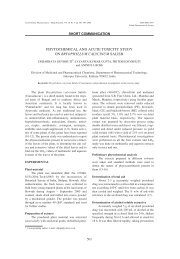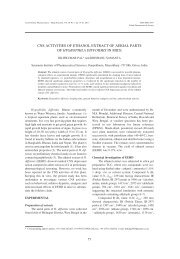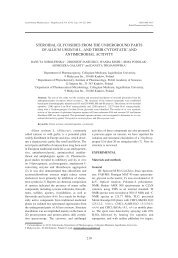determination of risperidone in tablets in the presence of its
determination of risperidone in tablets in the presence of its
determination of risperidone in tablets in the presence of its
Create successful ePaper yourself
Turn your PDF publications into a flip-book with our unique Google optimized e-Paper software.
Acta Poloniae Pharmaceutica ñ Drug Research, Vol. 66 No. 5 pp. 461ñ470, 2009 ISSN 0001-6837<br />
Polish Pharmaceutical Society<br />
ANALYSIS<br />
DETERMINATION OF RISPERIDONE IN TABLETS IN THE PRESENCE OF<br />
ITS DEGRADATION PRODUCTS AND PLACEBO-DERIVED CONSTITUENTS<br />
ANNA MAåLANKA*, JAN KRZEK and ALEKSANDER PATRZA£EK<br />
Department <strong>of</strong> Inorganic and Analytical Chemistry, Jagiellonian University, Collegium Medicum,<br />
9 Medyczna St., 30-688 KrakÛw, Poland<br />
Abstract: New chromatographicñdensitometric assay was developed for identification and <strong>determ<strong>in</strong>ation</strong> <strong>of</strong><br />
<strong>risperidone</strong> <strong>in</strong> pharmaceutical formulations. Th<strong>in</strong>-layer chromatographic plates (TLC-F 254 ) as a stationary phase<br />
and n-butanolñacetic acidñwater (12:3:5 v/v/v) as a mobile phase were used for separation. Densitometric<br />
measurements were done for all constituents at λ = 280 nm. A decrease <strong>in</strong> stability <strong>of</strong> <strong>risperidone</strong> was observed<br />
<strong>in</strong> acidic, basic and antioxidant solutions. Degradation <strong>of</strong> active pharmaceutical <strong>in</strong>gredient was consistent with<br />
first-order k<strong>in</strong>etics and unrelated to <strong>the</strong> solution. This assay is specific for <strong>risperidone</strong>. No <strong>in</strong>terference <strong>of</strong> tablet<br />
orig<strong>in</strong> adjuvants and degradation products were observed. Moreover, high sensitivity, limit <strong>of</strong> detection (0.22<br />
µg/spot), limit <strong>of</strong> quantitation (0.67 µg/spot), recovery (98.2ñ100.82%), broad l<strong>in</strong>ear range (0.09 µg/spot to<br />
1.40 µg/spot) and accuracy (1.87% RSD) are characteristic tra<strong>its</strong> <strong>of</strong> <strong>the</strong> chromatographicñdensitometric assay.<br />
Keywords: pharmaceutical preparation analysis, TLC, densitometry, <strong>risperidone</strong><br />
Risperidone represents atypical neuroleptics<br />
and is classified on <strong>the</strong> basis <strong>of</strong> chemical constitution<br />
among neuroleptics that are derivatives <strong>of</strong> various<br />
heterocyclic systems with cyclic structure.<br />
Risperidone is a tetrahydropyrido[1,2-a]-pyrimid<strong>in</strong>-<br />
4-one derivative with 6-fluoro-3-(4-piperid<strong>in</strong>yl)-<br />
1,2-benzisoxazole group, as shown below (1):<br />
Risperidone ñ 4-[2-[4-(6-fluorobenzo[d]isoxazol-3-<br />
yl)-1-piperidyl]ethyl]-3-methyl-2,6-diazabicyclo[4.4.0]deca-1,3-dien-5-one<br />
Absorption assay by <strong>in</strong>frared spectrophotometry and<br />
liquid chromatography (LC) are recommended for<br />
estimation <strong>of</strong> <strong>the</strong> quality <strong>of</strong> <strong>risperidone</strong> by <strong>determ<strong>in</strong>ation</strong><br />
<strong>of</strong> substance accord<strong>in</strong>g to Polish<br />
Pharmacopoeia VII. High-performance liquid chromatography<br />
(HPLC) is used for purity analysis.<br />
However, a method <strong>of</strong> chloric(VII) acid titration<br />
with potentiometric <strong>determ<strong>in</strong>ation</strong> <strong>of</strong> end-po<strong>in</strong>t is<br />
used for quantitative analysis (2).<br />
Chromatographic methods, ma<strong>in</strong>ly LC and<br />
HPLC, have significant role <strong>in</strong> <strong>determ<strong>in</strong>ation</strong> <strong>of</strong><br />
<strong>risperidone</strong> and <strong>its</strong> impurities. HPLC, liquid chromatography<br />
coupled with mass spectrometry<br />
(LC/MS) and nuclear magnetic resonance (NMR)<br />
were used for identification and structural analyses<br />
<strong>of</strong> impurities and degradation products <strong>of</strong> <strong>risperidone</strong><br />
(3-5). Determ<strong>in</strong>ations <strong>of</strong> <strong>risperidone</strong> and 9-<br />
hydroxy<strong>risperidone</strong>, an active metabolite, <strong>in</strong> biological<br />
material were accomplished us<strong>in</strong>g LC/MS<br />
method (6ñ15). Determ<strong>in</strong>ation <strong>of</strong> <strong>risperidone</strong> and <strong>its</strong><br />
degradation products <strong>in</strong> <strong>tablets</strong> (16, 17), and biologic<br />
material (18ñ23) were performed us<strong>in</strong>g HPLC<br />
method coupled with mass spectrometry or spectrophotometric<br />
detection. TLC 60-F 254 plates and<br />
acetonitrileñmethanolñ1-propanolñtriethanolam<strong>in</strong>e<br />
(8.5:1.2:0.6:0.2 v/v/v/v) mobile phase were used for<br />
separation <strong>of</strong> degradation products <strong>of</strong> <strong>risperidone</strong>.<br />
Densitometric measurements were used for detection<br />
under UV light at λ = 280 nm (17). Capillary<br />
electrophoresis (CE) was also used as a separation<br />
method for <strong>determ<strong>in</strong>ation</strong> <strong>of</strong> <strong>risperidone</strong> (24, 25).<br />
Polarography (26), chemilum<strong>in</strong>escence (27) and<br />
colorimetry (28) were used amongst o<strong>the</strong>r analytical<br />
* Correspond<strong>in</strong>g author: e-mail: amasl@cm-uj.krakow.pl<br />
461
462 ANNA MAåLANKA et al.<br />
methods for <strong>the</strong> <strong>determ<strong>in</strong>ation</strong> <strong>of</strong> <strong>risperidone</strong> <strong>in</strong><br />
<strong>tablets</strong> and biological material.<br />
This research paper deals with <strong>the</strong> development<br />
<strong>of</strong> new chromatographicñdensitometric assay<br />
for identification and <strong>determ<strong>in</strong>ation</strong> <strong>of</strong> <strong>risperidone</strong> <strong>in</strong><br />
<strong>tablets</strong> and <strong>its</strong> degradation products that can occur <strong>in</strong><br />
acidic and basic solutions, as well as <strong>in</strong> <strong>the</strong> <strong>presence</strong><br />
<strong>of</strong> oxidiz<strong>in</strong>g or reduc<strong>in</strong>g agents.<br />
EXPERIMENTAL<br />
Apparatus<br />
(a) TLC ñ Densitometer ñ Scanner 3 equipped<br />
<strong>in</strong> Cats 4.0x s<strong>of</strong>tware, L<strong>in</strong>omat IV (Camag, Muttenz,<br />
Switzerland); (b) TLC alum<strong>in</strong>um plates covered by<br />
silica gel (20 ◊ 20 cm, Merck, Germany) that were cut<br />
<strong>in</strong>to 10 ◊ 10 cm plates; (c) Chromatographic chamber<br />
18 ◊ 9 ◊ 18 cm (Sigma Aldrich); (d) Balance scale,<br />
WPA 60/C model, 0.1 mg accuracy (Radwag,<br />
Poland); (e) Bench centrifuge, MPW-223e model<br />
(MPW Med. Instruments, Poland).<br />
Reagents<br />
Methanol (POCH, Gliwice, Poland), 1-butanol<br />
(Chempur, Piekary ålπskie, Poland), acetic acid<br />
(Chempur, Piekary ålπskie, Poland), all analytical<br />
grade.<br />
Reference substances and formulations<br />
A substance that meets requirements <strong>of</strong> Polish<br />
Pharmacopoeia VI and European Pharmacopoeia<br />
Monographs was used dur<strong>in</strong>g studies: Risperidone<br />
CRS ñ LGC Promochem Sp.z o.o, Poland; coated<br />
<strong>tablets</strong> <strong>of</strong> Risperdal (4 mg) manufactured by<br />
Janssen-Cilag, France, placebo: lactose, corn starch,<br />
microcrystall<strong>in</strong>e cellulose, hydroxypropyl methyl<br />
cellulose, magnesium stearate, anhydrous colloidal<br />
silica, sodium lauryl sulfate.<br />
Reference solutions<br />
Amount <strong>of</strong> 5.6 mg <strong>of</strong> comparative substance<br />
was dissolved <strong>in</strong> 5.0 mL <strong>of</strong> methanol and mixed.<br />
Solutions at <strong>the</strong> follow<strong>in</strong>g concentrations: 0.560<br />
mg/mL, 0.280 mg/mL, 0.140 mg/mL, 0.070 mg/mL,<br />
0.035 mg/mL and 0.0175 mg/mL were obta<strong>in</strong>ed by<br />
dilution <strong>of</strong> stock solution with methanol.<br />
Solutions for stability analysis<br />
Coated <strong>tablets</strong> <strong>of</strong> Risperdal formulation were<br />
used after remov<strong>in</strong>g a coat<strong>in</strong>g by water wett<strong>in</strong>g.<br />
Powdered tablet mass correspond<strong>in</strong>g to 32.0 mg <strong>of</strong><br />
<strong>risperidone</strong> was extracted with 16.0 mL <strong>of</strong> methanol<br />
followed by shak<strong>in</strong>g for 15 m<strong>in</strong>. Suspension was<br />
centrifuged at 3000 rpm and supernatant was collected.<br />
Each time, <strong>the</strong> volume <strong>of</strong> 1.5 mL <strong>of</strong> solution<br />
was evaporated to dryness.<br />
Acidic solution<br />
A volume <strong>of</strong> 4 mL 0.5 mol/L HCl was added to<br />
dried residue. The solution was poured <strong>in</strong>to 0.5-mL<br />
glass vials. The solutions were heated at 100 O C,<br />
simultaneously samples for fur<strong>the</strong>r studies were collected<br />
after 1, 2, 3 and 5 h. After cool<strong>in</strong>g down, <strong>the</strong><br />
collected solutions were diluted immediately with<br />
methanol at a ratio <strong>of</strong> 1:1.<br />
Basic solution<br />
Volumes <strong>of</strong> 1 mL methanol and 3 mL <strong>of</strong> 0.5<br />
mol/L NaOH were added to dried residue. Dissolved<br />
solution was poured <strong>in</strong>to 0.5-ml glass vials.<br />
Solutions were heated at 100 O C and simultaneously<br />
samples for fur<strong>the</strong>r studies were collected after 1, 2,<br />
3 and 5 h. After cool<strong>in</strong>g down, <strong>the</strong> solutions were<br />
diluted immediately with methanol at a ratio <strong>of</strong> 1:1.<br />
Oxidant solution<br />
A volume <strong>of</strong> 4-mL 0.9 mol/L H 2 O 2 ñmethanol<br />
solution was added to <strong>the</strong> dried residue. The solution<br />
was left at room temperature (RT). Samples for fur<strong>the</strong>r<br />
studies were collected after 0.5, 1, 2 and 5 h.<br />
Reductant solution<br />
A volume <strong>of</strong> 4-mL waterñmethanol 0.1 mol/L<br />
Na 2 S 2 O 3 solution was added to dried sample. The<br />
solution was left at RT. Samples for fur<strong>the</strong>r studies<br />
were collected after 1, 2, 7 h and 14 days.<br />
Pharmaceutical agent solution for <strong>risperidone</strong> <strong>determ<strong>in</strong>ation</strong><br />
Powdered tablet mass correspond<strong>in</strong>g to 4.0 mg<br />
<strong>of</strong> <strong>risperidone</strong> was extracted with 4.0 mL <strong>of</strong><br />
methanol, shaken for 15 m<strong>in</strong> and centrifuged.<br />
Supernatant was diluted 10 times with methanol.<br />
Chromatographic analysis<br />
Volumes <strong>of</strong> 5 mL <strong>of</strong> reference solution and<br />
degradation solutions were applied to chromatographic<br />
plates (TLC, 10 ◊ 10 cm) us<strong>in</strong>g an applicator.<br />
Chromatograms were developed as far as 9.5<br />
cm, us<strong>in</strong>g mobile phase: n-butanolñacetic<br />
acidñwater (12:3:5 v/v/v), dried at RT and recorded<br />
under UV light. Densitometric record<strong>in</strong>g was done<br />
at λ = 280 nm. This wavelength was chosen on <strong>the</strong><br />
basis <strong>of</strong> directly recorded spectrum on chromatogram.<br />
Retardation factor value (R F ~ 0.49) and<br />
UV absorption spectrum recorded directly from<br />
chromatogram were used for identification <strong>of</strong><br />
<strong>risperidone</strong>.
Determ<strong>in</strong>ation <strong>of</strong> <strong>risperidone</strong> <strong>in</strong> <strong>tablets</strong> <strong>in</strong> <strong>the</strong> <strong>presence</strong> <strong>of</strong>... 463<br />
Table 1. Parameters <strong>of</strong> separation.<br />
Constitues TLC plates HPTLC plates<br />
(1) : (2) R F(1) R F(2) α R s R F(1) R F(2) α R s<br />
Risperidone : peak 2<br />
solution HCl<br />
~0.49 ~0.79 4.00 4.21 ~0.53 ~0.78 3.18 4.09<br />
peak 2 : Risperidone<br />
solution NaOH<br />
~0.43 ~0.48 1.22 0.70 ~0.44 ~0.51 1.32 0.91<br />
Risperidone : peak 4<br />
solution NaOH<br />
~0.48 ~0.72 2.77 3.43 ~0.51 ~0.70 2.23 3.22<br />
Risperidone : peak 2<br />
solution H 2 O 2<br />
~0.48 ~0.50 1.08 0.63 ~0.53 ~0.56 1.13 0.60<br />
R F ñ retardation factor, a ñ separation factor, R s ñ resolution factor<br />
R s ñ resolution factor, R s = 2 ◊ (distance between <strong>the</strong> centers <strong>of</strong> two adjacent spots)/(sum <strong>of</strong> <strong>the</strong> widths <strong>of</strong> <strong>the</strong> two spots <strong>in</strong> <strong>the</strong> direction<br />
<strong>of</strong> development)<br />
Table 2. Percentage content <strong>of</strong> <strong>risperidone</strong> <strong>in</strong> <strong>the</strong> <strong>presence</strong> <strong>of</strong> degradation products <strong>in</strong> solutions: NaOH, HCl, H 2 O 2 and Na 2 S 2 O 3 . K<strong>in</strong>etics<br />
parameters <strong>of</strong> degradation reaction <strong>in</strong> <strong>in</strong>dividual solutions.<br />
0.5 mol/L NaOH 0.5 mol/L HCl 0.9 mol/L H 2 O 2 0.1 mol/L Na 2 S 2 O 3<br />
Content <strong>of</strong> Content <strong>of</strong> Content <strong>of</strong> Content <strong>of</strong><br />
Time <strong>risperidone</strong> Time <strong>risperidone</strong> Time <strong>risperidone</strong> Time <strong>risperidone</strong><br />
[%] [%] [%] [%]<br />
1 h 0.073 1 h 0.074 0.5 h 0.031 1 h 0.150<br />
2 h 0.066 2 h 0.072 1 h 0.028 2 days 0.150<br />
3 h 0.062 3 h 0.069 2 h 0.027 7 days 0.150<br />
5 h 0.055 5 h 0.065 5 h 0.020 14 days 0.150<br />
k = 0.0692 h -1 ± 0.0267 h -1 k = 0.0334 h -1 ± 0.0062 h -1 k = 0.0926 h -1 ± 0.0396 h -1<br />
t 0.1 = 1.52 h t 0.1 = 3.15 h t 0.1 = 1.37 h ó-<br />
t 0.5 = 10.01 h t 0.5 = 20.75 h t 0.5 = 7.48 h<br />
k ñ reaction rate constant, t 0.1 ñ degradation time <strong>of</strong> 10% substrate, t 0.5 ñ degradation time <strong>of</strong> 50% substrate<br />
K<strong>in</strong>etics estimation<br />
Determ<strong>in</strong>ation <strong>of</strong> <strong>risperidone</strong> was done by <strong>the</strong><br />
use <strong>of</strong> k<strong>in</strong>etics parameters (29).<br />
Assay validation<br />
Assay validation was done by <strong>determ<strong>in</strong>ation</strong> <strong>of</strong><br />
specificity, accuracy, l<strong>in</strong>earity, limit <strong>of</strong> detection<br />
and quantification, stability, and robustness (30).<br />
Specificity<br />
Assay specificity was determ<strong>in</strong>ed by compar<strong>in</strong>g<br />
peak areas, R F values and absorption spectra recorded<br />
for reference solution <strong>in</strong> <strong>the</strong> <strong>presence</strong> <strong>of</strong> placebo.<br />
Model mixtures conta<strong>in</strong><strong>in</strong>g lactose, starch corn,<br />
microcrystall<strong>in</strong>e cellulose, hydroxypropyl methyl<br />
cellulose, magnesium stearate, anhydrous colloidal<br />
silica and sodium lauryl sulfate were prepared (Fig.<br />
1). Placebo was added to <strong>the</strong>se model mixtures.<br />
Accuracy<br />
Assay accuracy was determ<strong>in</strong>ed by estimat<strong>in</strong>g<br />
recovery percentage (%E) for chosen constituents.<br />
Known amount <strong>of</strong> reference substances (80% to 120%<br />
declared content) were added to model solutions already<br />
conta<strong>in</strong><strong>in</strong>g placebo constituents. Recovery <strong>in</strong> percentage<br />
value was calculated on <strong>the</strong> basis <strong>of</strong> determ<strong>in</strong>ed content<br />
<strong>of</strong> <strong>in</strong>dividual constituents to weighed amount (Table 3).<br />
Precision<br />
Consistency <strong>of</strong> experimentally determ<strong>in</strong>ed results<br />
was checked on <strong>the</strong> model solutions prepared by dissolv<strong>in</strong>g<br />
<strong>the</strong> substance <strong>in</strong> methanol. Five <strong>determ<strong>in</strong>ation</strong>s<br />
were done for each model solution (Table 3).<br />
Indirect precision<br />
Determ<strong>in</strong>ation was done for <strong>the</strong> model solutions<br />
by two analytical chemists <strong>in</strong> two different<br />
days. In each case, five <strong>determ<strong>in</strong>ation</strong>s were done<br />
for each model solution (Table 3).<br />
L<strong>in</strong>earity<br />
L<strong>in</strong>earity was determ<strong>in</strong>ed as <strong>the</strong> relationship <strong>of</strong><br />
peak areas (p [mm 2 ]) to mass [mg/spot]. Five meas-
464 ANNA MAåLANKA et al.<br />
Figure 1. Densitogram <strong>of</strong> methanol solution <strong>of</strong> placebo constituents <strong>of</strong> pharmaceutical formulation after extraction <strong>of</strong> 1.0 g <strong>of</strong> powdered<br />
mass with 10.0 mL <strong>of</strong> methanol.<br />
Fig. 2. Densitogram <strong>of</strong> methanol extract <strong>of</strong> <strong>risperidone</strong> from pharmaceutical formulation.<br />
urements were done for concentrations 0.018<br />
mg/mL to 0.280 mg/mL, apply<strong>in</strong>g 5.0 mL <strong>of</strong> each<br />
solution. The measurement <strong>of</strong> l<strong>in</strong>earity <strong>of</strong> <strong>risperidone</strong><br />
was shown as a straight l<strong>in</strong>e equation with <strong>the</strong><br />
content <strong>of</strong> correlation coefficient (r): p = 4134.3 ◊ m<br />
+ 742.9, r = 0.99657.<br />
Limit <strong>of</strong> detection (LOD) and limit <strong>of</strong> quantitation<br />
(LOQ)<br />
Us<strong>in</strong>g standard deviation and slope <strong>of</strong> a<br />
straight l<strong>in</strong>e coefficient, <strong>the</strong> values <strong>of</strong> LOD and LOQ<br />
were determ<strong>in</strong>ed us<strong>in</strong>g <strong>the</strong> follow<strong>in</strong>g equations:<br />
LOD = 3.3 ◊ S y /a, LOQ = 10 ◊ S y /a, where: S y ñ<br />
error <strong>of</strong> estimation, a ñ slope <strong>of</strong> a straight l<strong>in</strong>e coefficient<br />
(Table 3).<br />
Stability<br />
Methanol extract was prepared from<br />
Risperdal <strong>tablets</strong> at concentration 1.0 mg/mL <strong>of</strong><br />
<strong>risperidone</strong>. The methanol extract was stored at RT<br />
and also at 5 O C for 7 days. Determ<strong>in</strong>ation <strong>of</strong> <strong>the</strong><br />
content was done ex tempore (without pretreat-
Determ<strong>in</strong>ation <strong>of</strong> <strong>risperidone</strong> <strong>in</strong> <strong>tablets</strong> <strong>in</strong> <strong>the</strong> <strong>presence</strong> <strong>of</strong>... 465<br />
Fig. 3. Absorption spectrum <strong>of</strong> <strong>risperidone</strong> recorded directly from chromatogram<br />
Fig. 4. Densitogram <strong>of</strong> <strong>risperidone</strong> (peak 1) and <strong>its</strong> degradation product (peak 2) <strong>in</strong> acidic solution.<br />
ment) and after 24 h, 48 h and a whole week<br />
aga<strong>in</strong>st reference solutions prepared directly before<br />
<strong>determ<strong>in</strong>ation</strong> (Table 4).<br />
Robustness<br />
The impact <strong>of</strong> replacement <strong>of</strong> TLC 60-F 254<br />
plates with HPTLC-F 254 plates covered by silica 60<br />
was studied. Volume <strong>of</strong> 5 µL <strong>of</strong> each solution after<br />
hydrolysis <strong>in</strong> HCl and NaOH solutions were<br />
applied on both types <strong>of</strong> plates. Then, <strong>the</strong> plates<br />
have undergone chromatographic analysis.<br />
Separation and resolution factors were calculated<br />
for two adjacent peaks on <strong>the</strong> basis <strong>of</strong> developed<br />
densitograms (Table 1).<br />
Determ<strong>in</strong>ation <strong>of</strong> <strong>risperidone</strong> <strong>in</strong> pharmaceutical<br />
formulation<br />
Usability <strong>of</strong> this assay was proved on pharmaceutical<br />
formulation. The results are presented <strong>in</strong><br />
Table 2.
466 ANNA MAåLANKA et al.<br />
Fig. 5. Densitogram <strong>of</strong> <strong>risperidone</strong> (peak 3) and <strong>its</strong> degradation product (peak: 1, 2 and 4) <strong>in</strong> basic solution.<br />
Fig. 6. Densitogram <strong>of</strong> <strong>risperidone</strong> (peak 1) and <strong>its</strong> degradation product (peak: 2) <strong>in</strong> hydrogen peroxide solution.<br />
RESULTS AND DISCUSSION<br />
Accord<strong>in</strong>g to assumption made <strong>in</strong> this paper,<br />
new chromatographicñdensitometric assay allows<br />
for simultaneous identification and quantity analysis<br />
<strong>of</strong> <strong>risperidone</strong> <strong>in</strong> pharmaceutical formulations <strong>in</strong> <strong>the</strong><br />
<strong>presence</strong> <strong>of</strong> degradation products occurr<strong>in</strong>g <strong>in</strong><br />
acidic, basic and hydrogen peroxide solutions.<br />
Good results <strong>of</strong> chromatographic separation<br />
were obta<strong>in</strong>ed by us<strong>in</strong>g n-butanolñacetic acidñwater<br />
(12:3:5 v/v/v) mobile phase and TLC-F 254 plates<br />
covered with silica gel 60. Peak <strong>of</strong> <strong>risperidone</strong> is<br />
symmetrical and well-shaped under develop<strong>in</strong>g conditions.<br />
It allows for easy identification and quality<br />
analysis (Fig. 1, 2).<br />
Characteristic absorption spectrum recorded<br />
directly from chromatograms can be useful for identity<br />
studies. Moreover, this spectrum allows to<br />
choose analytical wavelength at λ = 280 nm (Fig. 3).<br />
Risperidone-orig<strong>in</strong> peaks (R F ~ 0.49) always<br />
occur close to degradation products on recorded<br />
chromatograms for studied and comparative solutions
Determ<strong>in</strong>ation <strong>of</strong> <strong>risperidone</strong> <strong>in</strong> <strong>tablets</strong> <strong>in</strong> <strong>the</strong> <strong>presence</strong> <strong>of</strong>... 467<br />
Fig. 7. Densitogram <strong>of</strong> <strong>risperidone</strong> <strong>in</strong> sodium thiosulfate(VI) solution.<br />
Fig. 8. Logarithmic dependence <strong>of</strong> <strong>risperidone</strong> concentration to degradation time <strong>in</strong> HCl, NaOH and hydrogen peroxide solutions.<br />
Regressionequations: 1: log c = 0.0145 ◊ t ñ 1.1178, <strong>in</strong> acidic solution; 2: log c = 0.0297 ◊ t ñ 1.1129, <strong>in</strong> basic solution; 3: log c = 0.0402<br />
◊ t ñ 1.4968, <strong>in</strong> hydrogen peroxide solution.<br />
<strong>in</strong> established conditions. It could be assumed that<br />
this assay is specific aga<strong>in</strong>st tested constituent and it<br />
guarantees that <strong>the</strong> obta<strong>in</strong>ed results are reliable.<br />
Exemplary densitograms <strong>of</strong> degradation products<br />
<strong>of</strong> <strong>risperidone</strong> are presented <strong>in</strong> Figures 4ñ7. The<br />
peaks <strong>of</strong> products degradation orig<strong>in</strong> that differ with<br />
retention coefficient values, which depend on solution<br />
<strong>of</strong> <strong>the</strong>ir orig<strong>in</strong>, are observed on chromatographic<br />
densitograms <strong>in</strong> acidic, basic and hydrogen peroxide<br />
solutions.<br />
Separation <strong>of</strong> <strong>risperidone</strong> from <strong>its</strong> degradation<br />
products was satisfactory under studied conditions<br />
(Table 1). No significant differences were observed<br />
when stationary phase was changed by replacement<br />
<strong>of</strong> TLC with HPTLC plates.<br />
The <strong>presence</strong> <strong>of</strong> one degradation product <strong>of</strong><br />
<strong>risperidone</strong> <strong>in</strong> a solution <strong>of</strong> 0.5-mol/L acetic acid (R F<br />
~ 0.79) was observed toge<strong>the</strong>r with <strong>the</strong> peak <strong>of</strong><br />
tested constituent (R F ~ 0.49) under develop<strong>in</strong>g<br />
conditions (Fig. 4). Three degradation products
468 ANNA MAåLANKA et al.<br />
Table 3. Assay validation parameters.<br />
Validation parameters Value <strong>of</strong> validation parameter Statistical estimation<br />
LOD<br />
[mg/spot]<br />
0.222 ó-<br />
LOQ<br />
[mg/spot]<br />
0.672 ó-<br />
95,96 x ñ = 98.27<br />
Recovery 97,81 S x = 2.332<br />
80 % 101,29 t 95% = ±2.89<br />
[%] 96,27 RSD = 2.37<br />
100,03<br />
101,89<br />
Recovery 99,76 x ñ = 99.60<br />
100 % 98,40 S x = 1.761<br />
[%] 97,41 t 95% = ±2.18<br />
100,55 RSD = 1.76<br />
101,63<br />
Recovery 100,58 x ñ = 100.82<br />
120 % 101,30 S x = 1.162<br />
[%] 101,70 t 95% = ±1.44<br />
98,90 RSD = 0.01<br />
4,10<br />
4,02 x ñ = 4.00<br />
Precision 3,92 S x = 0.075<br />
[mg/4 mL] 3,93 t 95% = ±0.093<br />
4,03 RSD = 1.87<br />
3,97<br />
Indirect precision 3,91 x ñ = 4.01<br />
[mg/4 mL] 3,96 S x = 0.100<br />
Analytical chemist I 4,11 t 95% = ±0.125<br />
4,14 RSD = 2.50<br />
3,91<br />
Indirect precision 4,12 x ñ = 4.01<br />
[mg/4 mL] 4,08 S x = 0.103<br />
Analytical chemist I 3,90 t 95% = ±0.128<br />
4,07 RSD = 2.56<br />
Regression equation p = 3729.9 ◊ m + 212.1<br />
Correlation coefficient r = 0.99411 ó-<br />
R F ñ retardation factor; x ñ ñ mean value; S x ñ standard deviation, t 95% ñ confidence <strong>in</strong>terval for 95% probability; RSD ñ relative standard<br />
deviation; p ñ peak surface area [mm 2 ]; m ñ mass [mg/spot]; r ñ correlation coefficient<br />
(R F ~ 0.40, R F ~ 0.48 and R F ~ 0.72) were observed<br />
<strong>in</strong> a solution <strong>of</strong> 0.5 mol/L sodium hydroxide (Fig. 5).<br />
Degradation product with R F ~ 0.50 was detected <strong>in</strong><br />
<strong>the</strong> <strong>presence</strong> <strong>of</strong> hydrogen peroxide (Fig. 6). No<br />
<strong>in</strong>fluence <strong>of</strong> sodium thiosulfate(VI) was observed on<br />
robustness <strong>of</strong> <strong>risperidone</strong> (Fig. 7).<br />
In conclusion, <strong>the</strong> solution, where <strong>the</strong> stability<br />
<strong>of</strong> <strong>risperidone</strong> was studied, has an impact on type<br />
and number <strong>of</strong> degradation products that differ with<br />
<strong>the</strong> values <strong>of</strong> retardation factor. It has to be highlighted<br />
that <strong>the</strong> impact <strong>of</strong> degradation process on<br />
method specificity was not observed.<br />
Interest<strong>in</strong>g conclusions can be made on <strong>the</strong><br />
basis <strong>of</strong> concentrations change <strong>of</strong> <strong>risperidone</strong> to time<br />
<strong>of</strong> measurement. Degradation process is <strong>in</strong>dependent<br />
on conditions but is consistent with k<strong>in</strong>etics <strong>of</strong><br />
<strong>the</strong> first-order reaction (Fig. 8).<br />
Reaction rate constant (k) demonstrates various<br />
values <strong>in</strong> different solutions. Degradation is <strong>the</strong><br />
fastest <strong>in</strong> hydrogen peroxide solution (k = 0.0926 h -1 ),<br />
followed by basic solution (k = 0.0692 h -1 ) and <strong>the</strong><br />
slowest <strong>in</strong> acidic solution (k = 0.0334 h -1 ).<br />
Risperidone ma<strong>in</strong>ta<strong>in</strong>s <strong>its</strong> stability dur<strong>in</strong>g 14 days <strong>of</strong><br />
storage <strong>in</strong> <strong>the</strong> <strong>presence</strong> <strong>of</strong> reduc<strong>in</strong>g agent.
Determ<strong>in</strong>ation <strong>of</strong> <strong>risperidone</strong> <strong>in</strong> <strong>tablets</strong> <strong>in</strong> <strong>the</strong> <strong>presence</strong> <strong>of</strong>... 469<br />
Table 4. Stability <strong>of</strong> methanol extract <strong>of</strong> <strong>risperidone</strong> from <strong>tablets</strong>.<br />
Content <strong>of</strong> stored solution at 23 O C [µg]<br />
Content <strong>of</strong> stored solution at 5 O C [µg]<br />
Ex tempore After 1 day After 2 days After 7 days After 1 day After 2 days After 7 days<br />
1.10 1.15 1.20 1.17 1.15 1.15 1.13<br />
Table 5. Determ<strong>in</strong>ation results <strong>of</strong> <strong>the</strong> content <strong>of</strong> <strong>risperidone</strong> <strong>in</strong> <strong>the</strong> pharmaceutical formulation studied.<br />
Formulation Determ<strong>in</strong>ed content Statistical<br />
(declared content) [mg/tablet] estimation<br />
4.10 x ñ = 4.00<br />
Risperdal 4.02 S x = 0.075<br />
3.92 t 0,95 = ±0.093<br />
(4 mg/tablet) 3.93 RSD = 1.87%<br />
4.03 E = 0.00%<br />
x ñ ñ mean value; S x ñ standard deviation, t 95% ñ confidence <strong>in</strong>terval for 95% probability; RSD ñ relative standard deviation; E ñ relative<br />
error<br />
A suggestion can be made on <strong>the</strong> basis <strong>of</strong> <strong>the</strong><br />
calculated values t 0.1 and t 0.5 that <strong>the</strong> smallest impact<br />
on stability <strong>of</strong> <strong>risperidone</strong> has <strong>the</strong> reduc<strong>in</strong>g agent and<br />
<strong>the</strong> highest one has hydrogen peroxide (Table 2).<br />
This new chromatographicñdensitometric<br />
method has high sensitivity (LOD = 0.222 mg, LOQ<br />
= 0.672 µg). A recovery <strong>of</strong> tested substance was<br />
98.27%, 99.60% and 100.82% for <strong>the</strong> levels <strong>of</strong>:<br />
80%, 100% and 120%, respectively. L<strong>in</strong>earity range<br />
was with<strong>in</strong> 0.087 mg/spot to 1.400 µg/spot. This<br />
method is very accurate (RSD = 1.87%). No impact<br />
on <strong>the</strong> results and values was observed dur<strong>in</strong>g test<strong>in</strong>g<br />
this method by two different analytical chemists<br />
(RSD = 2.50% and 2.56%) (Table 3).<br />
Methanol extracts <strong>of</strong> <strong>risperidone</strong> made from<br />
pharmaceutical formulation have ma<strong>in</strong>ta<strong>in</strong>ed <strong>the</strong>ir<br />
stability for 7 days dur<strong>in</strong>g storage <strong>in</strong> 5 O C or RT<br />
(Table 4).<br />
This assay is also specific aga<strong>in</strong>st placebo constituents,<br />
as well as degradation products (Fig. 1).<br />
Quantity analysis <strong>of</strong> <strong>risperidone</strong> was done <strong>in</strong> pharmaceutical<br />
formulation (Table 5). Developed assay<br />
has satisfactory accuracy and precision. The determ<strong>in</strong>ed<br />
content <strong>of</strong> pharmaceutical formulation was<br />
like declared. Relative error is 0.00%.<br />
CONCLUSION<br />
Developed chromatographicñdensitometric<br />
assay allows for fast and direct <strong>determ<strong>in</strong>ation</strong> <strong>of</strong><br />
<strong>risperidone</strong> <strong>in</strong> <strong>the</strong> <strong>presence</strong> <strong>of</strong> constituents from<br />
placebo formulation and degradation products.<br />
This assay is very sensitive and has broad l<strong>in</strong>earity<br />
range, good accuracy and precision. It can be<br />
used for quality evaluation <strong>of</strong> pharmaceutical formulations<br />
dur<strong>in</strong>g manufactur<strong>in</strong>g and distribution, as<br />
well as <strong>the</strong>ir stability.<br />
REFERENCES<br />
1. Zejc A., Gorczyca M.: Chemistry <strong>of</strong> drugs (<strong>in</strong><br />
Polish), PZWL, Warszawa 2002.<br />
2. Polish Pharmacopoeia VI, Polish<br />
Pharmaceutical Society, Warszawa 2002.<br />
3. Sattanathan P., Babu J.M., Vyas K.: J. Pharm.<br />
Biomed. Anal. 24, 598 (2005).<br />
4. Tomar R.S., Joseph T.J., Murthy A.S.: J.<br />
Pharm. Biomed. Anal. 36, 231 (2004).<br />
5. Bharathi Ch., Chary D.K., Kumar M.S.: J.<br />
Pharm. Biomed. Anal. 46, 165 (2008).<br />
6. Roman M., Kronstrand R., L<strong>in</strong>dstedt.: J. Anal.<br />
Toxicol. 32, 147 (2008).<br />
7. LLerena A., Berecz R., Dorado P., De la Garza<br />
C.S., Norberto M.J., C·ceres M., GutiÈrrez J.R.:<br />
J. Chromatogr. B 783, 213 (2003).<br />
8. Remmerie B.M.M., Sips L.L.A., De Vries R.,<br />
De Jong J., Schothuis A.M., Hooijschuur<br />
E.W.J., Van de Merbel N.C.: J. Chromatogr. B<br />
783, 461 (2003).<br />
9. De Meulder M., Remmerie B.M.M., de Vries<br />
R., Sips L.L.A., Boom S., Hooijschuur E.W.J.,<br />
van de Merbel N.C., Timmerman P.M.M.B.L.:<br />
J. Chromatogr. B 870, 8 (2008).<br />
10. »abowska B., Cox S.L., V<strong>in</strong>ks A.A.: J.<br />
Chromatogr. B 852, 497 (2007).<br />
11. Zhang L., Jiao Z., Yao Z., Zhong Y., Zhong M.,<br />
Yu Y.: Chromatographia 61, 245, (2005).<br />
12. Janowska E.: Probl. Forensic Sci. 58, 103<br />
(2004).
470 ANNA MAåLANKA et al.<br />
13. Zhang G., Terry Jr. A.V., Bartlett M.G.: J.<br />
Chromatogr. B 858, 276 (2007).<br />
14. Zhang G., Terry Jr. A.V., Bartlett M.G.: Rapid<br />
Commun. Mass Spectrom. 21, 920 (2007).<br />
15. Kirschbaum K.M., F<strong>in</strong>ger S., Vogel F., Burger<br />
R., Gerlach M., Riederer P., Hiemke C.:<br />
Chromatographia 67, 321 (2008).<br />
16. Orkoula M.G., Kontoyannis C.G.: J. Pharm.<br />
Biomed. Anal. 47, 631 (2008).<br />
17. El-Sherif ZA., El-Zeany B., El-Houss<strong>in</strong>i OM.:<br />
J. Pharm. Biomed. Anal. 36, 975 (2005).<br />
18. Kirchherr H., K¸hn-Velten W.N.: J.<br />
Chromatogr. B 843, 100 (2006).<br />
19. Huang M., Shentu J., Chen J.: J. Zhejiang Univ.<br />
Sci. B 9, 114 (2008).<br />
20. Nagasaki T., Ohkubo T., Sugawara K.: J.<br />
Pharm. Biomed. Anal. 19, 595 (1999).<br />
21. Zhang G., Terry Jr. A.V., Bartlett, M.G.: J.<br />
Chromatogr. B 856, 20 (2007).<br />
22. Moody D.E., Laycock J.D., Huang W., J. Anal.<br />
Toxicol. 28, 494 (2004).<br />
23. Zhou Z., Li X., Li K., Xie Z., Cheng Z., Peng<br />
W., Wang F., Li H.: J. Chromatogr. B<br />
802, 257 (2004).<br />
24. Danel C., Cham<strong>in</strong>ade P., Odou P., BartÈlÈmy<br />
C., Azarzar D., Bonte J.-P., Vaccher C.:<br />
Electrophoresis 28, 2683 (2007).<br />
25. Danel C., BarthÈlÈmy C., Azarzar D.: J.<br />
Chromatogr. A 1163, 228 (2007).<br />
26. Jeyaseelan C., Jugade R., Joshia A.P.: Croat.<br />
Chem. Acta 79, 541, (2006).<br />
27. Xie X.F., Shao X.D., Song Z.H.: Chem. Pap.<br />
60, 288 (2006).<br />
28. Hassan,W.E.-S.: Chem. Pharm. Bull. 56, 1092<br />
(2008).<br />
29. Atk<strong>in</strong>s P. W. Physical chemistry (Polish translation),<br />
PWN, Warszawa 2007.<br />
30. ICH guidel<strong>in</strong>e Q2B, Validation <strong>of</strong> Analytical<br />
Procedures: Methodology (CPMP CH/281/95),<br />
Geneva, Switzerland (1996).<br />
Received: 23. 03. 2009


